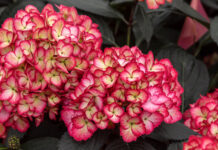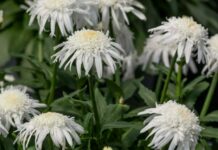By Christine Menapace
From the February 2023 Issue
The nursery industry is constantly finding ways to improve plants. Whether it’s stunning new colors, greater drought resistance, or a new growth habit, the introductions made each year help landscapers push the envelope of design. Here are award-winning, trialed, top choices for plantings in 2023.
Cultivar Creativity
Alicia Holloway, a University of Georgia (UGA) Cooperative Extension Agriculture and Natural Resources agent, says her garden is all about flowers. “I’m using a design strategy suggested by David Culp in his book, The Layered Garden. He recommends stretching the season of your favorite flowers by planting cultivars with different bloom times.”
For Holloway, this means she is mixing in new iris varieties with mid- and late-bloom times to her 50-square-feet of early-blooming heirloom iris. Since irises have multiple ornamental species and thousands of different cultivars, “I’ll have something blooming in that particular section of the garden from February through May.”
Holloway also uses cultivars of the same plant to create unity, while not being overly repetitive. Similar blooms, for instance, can be repeated in great swaths of color, while allowing for cultivars of different heights. “Creating a plant layout is similar to staging a class photo,” she says. “Tall kids in the back, shorties in the front…. Creating repetition at different heights gives you pockets of the same color, but in different planes.”
This strategy works well for flowering shrubs too. As yards have gotten smaller, plant breeders have worked to make smaller plants to fit them, says Holloway. Loropetalums, butterfly bushes, abelias, hydrangeas, azaleas, and crape myrtles, she says, all have at least one 2′ to 3′ cultivar in addition to standard-sized versions and every size in between.
While evergreens and grasses are often used for Winter color and structure, Holloway instead uses plants that provide these attributes, but also provide floral interest. “This strategy is all about using flowers for jobs that other plants are more traditional selected for. Right now, spurge is my favorite. More specifically, Euphorbia ‘Ascot Rainbow’…is evergreen in my Zone, has sage and lime foliage, and produces clouds of chartreuse blooms throughout Spring. Likewise, Kniphofia looks like a grass, but has funky flowers that inspired its common name, red-hot poker.”
She adds, “I’ll keep looking for new strategies to push more moments in the garden-year towards well-designed and indulgently floral visions.”
Triple Crown Plant Of 2023

No doubt, Rudbeckia ‘American Gold Rush’ may catch Holloway’s eye as it did for three major Industry groups, becoming the first ever “Triple Crown of Horticulture.” For All-America Selections (AAS), American Gold Rush is one of the first perennial winners from their 3-Winter trial and both the National Garden Bureau (NGB) and Perennial Plant Association (PPA) named it their 2023 Perennial of the Year as well.
PPA chose ‘American Gold Rush’ because at the height of summer it blooms for a long season of dazzling color right up to frost. The hairy foliage is also resistant to Septoria leaf spot – a debilitating fungal disease. ‘American Gold Rush’ is a reliable hardy perennial and a stunning focal point in perennial borders, meadows, and when massed in corporate landscapes.
AAS judges grew and evaluated ‘America Gold Rush’ for three years with resulting comments such as:
- “I believe this is one of the very best rudbeckias I’ve ever trialed and one of the very best perennials as well.”
- “Great habit and longevity.”
- “Would make an excellent addition to a yard, especially in a mass planting.”
The NGB chose rudbeckia as the 2023 Perennial of the Year for many reasons. Rudbeckias are native to much of North America, are pollinator friendly, easy to grow, and there are many new varieties.
National Winners
The NGB also recently announced its 2023 Green Thumb Award winners. These plants meet four criteria: uniqueness; technological innovation; ability to solve a gardening problem or provide an opportunity; and appeal. Winners included:

Flowering Shrub: Rose Eau De Parfum™ Bubbly (to Zone 5) by Monrovia. Big fragrant champagne-colored blooms with a high petal count and disease resistance. Blooms repeatedly from early Spring until the first frost and grows to 3′ to 4′ tall.
Perennial: Astilbe Dark Side of the Moon (Zones 4-9). The only dark leafed Astilbe with purple flowers on the market. Rich, deep chocolate burgundy leaves form an 18″ to 24″ mound of foliage. Dark stems hold raspberry buds with rosy, purple flowers.
Annual: Starflower Paper Moon. Small, pale blue blossoms on wiry stems transform into highly decorative, bronze-colored geo- metric and globe-shaped seed heads for both fresh and dried bouquets. Grows 2′ to 3′ tall and attract beneficial insects.

Annual: Colocasia esculenta Royal Hawaiian® Waikiki. Glossy green foliage with flamboyant white and flamingo pink veining that is happy in full sun. Disease resistance and a compact, clumping habit at 3′ tall and wide, it’s ideal for containers. Also a 2023 AAS National Winner.
Besides the Colocasia, AAS has two new Winners for 2023 landscapes. They include Coleus Premium Sun Coral Candy by PanAmerican Seed and Snapdragon DoubleShot™ Orange Bicolor F1 by Hem Genetics. They join previous announced 2023 winners, Echinacea Artisan Yellow Ombre F1; Leucanthemum Carpet Angel Daisy; and Salvia Blue by You F1, profiled here last July.
UGA Trial Winners
Each year, the Trial Gardens at the University of Georgia (UGA) also announces its top 12 Classic City Award winners from hundreds of entries. Trial Gardens staff plant and evaluate varieties sent by global breeders to test plant growth and performance in Georgia heat and humidity.
“A lot of these companies are in different climates and need to test their plants somewhere warmer and more humid,” comments John Ruter, Trial Gardens director. “Quality is not limited to fertility standards and spacing, quality is also what consumers, from landscapers to buyers, see when they have a little money to spend.”
Last Spring, the Trial Gardens team planted 400 varieties between April and May. Over the summer, the team monitored, maintained, and judged the plants. Sandra Begani, UGA Trial Gardens manager, says she evaluates the plants for uniformity, disease resistance, good leaf color, and minimal or no leaf dropping. These are good signs of predictability and ease of growth. “If all the plants look really similar, that’s a sign of predictability,” she said. “And that means it will probably be easier to predict how it will behave for consumers.”
Here are winners from the 2022 trial season with judges’ comments (edited for clarity/space):
- Calibrachoa Superbells® Prism™ ‘Pink Lemonade’ by Proven Winners. Visitors regularly asked if there were actually two different plants. The effect is fabulous and full.
- Caladium ‘Crystal Moon’ by Classic Caladiums. There were many caladiums for both sun and shade at the top of our list this year. Crystal Moon is a shade variety that lights up any wooded space.
- Catharanthus Soiree Flamenco® ‘Senorita Pink’ by Suntory. This new vinca hybrid is a part of the Soiree collection that has wowed for years. This introduction had the most interesting shape and healthy foliage in both moist and dry locations and still looked as good as day one.


- Coleus Premium Sun™ ‘Ruby Heart’ by PanAmerican Seed. This seeded coleus crop was outstanding. The plant is made up of waves of red, heart-shaped centers and golden edges. Plants form a perfect arrangement when planted in a group. The stems are sturdy without bolting, lodging, or stretching, and pruning was not required.
- Double Impatiens Glimmer™ ‘Appleblossom’ by Ball FloraPlant. This series was outstanding in concrete planters and hanging fiber baskets. Both locations were partially shaded and required frequent water and fertilization, but the plants produced bountiful double blooms all summer long and all were disease-free.
- Gerbera Garvinea® ‘Sweet Sparkle’ by HilverdaFlorist. Continuous blooms all summer long on flawless crowns of foliage. Flower heads were upright, and colors were bright. No wilting or crown rot.
- Hibiscus Hollywood™ ‘America’s Sweetheart’ by J. Berry Nursery. J. Berry does not disappoint in new colors and patterns in tropical hibiscus each year. This variety was successful in both containers and in the ground.
- Lantana Gem™ ‘Compact Orange Fire’ by Danziger Lantana. This lantana is a necessity in the Southeastern garden for heat, drought, pollinators, and deer resistance. The Gem™ series pro- vides unique color palettes. The ‘Compact Orange Fire’ made a very bold statement with deep red-orange clusters. The plants were perfectly round on very solid stems.
- MixMasters™ ‘Meant to Bee’ by Ball FloraPlant. Words can’t describe the color-power of these little bells, with hues that grow deeper in the center and explode with a perfect yellow star. This combo outlasted many others and continued to shine brightly.


- Petunia DuraBloom® ‘Electric Lilac’ by DummenOrange. The best petunia of the bunch. Both hanging baskets and containers overflowed with gigantic purple blooms all summer. Color intensity was amazing.
- Portulaca Mojave® ‘Yellow 2023’ by Proven Winners. It’s special not only because of its larger flower heads and strong branching structure, but it remained open longer during the day while others had already closed.
- Rex Begonia Jurassic Jr.™ ‘Fire Spike’ by Ball Ingenuity. The complex foliar patterns and abundant flowers on ‘Fire Spike’ had the best performance of all in both baskets and the landscape beds.
Menapace is the editorial director of Turf magazine and an avid gardener.
Do you have a comment? Share your thoughts below, or send an e-mail to the Editor at cmenapace@groupc.com.











![[VIDEO] Dickies®: Discover Workwear That’s Anything But Uniform](https://turfmagazine.com/wp-content/uploads/2023/06/1647663814-4b1a2a7742790a9b1e97a3b963477850192e1d6a9dfba9b07214a77bae25d6e3-d-218x150.jpg)






























![[VIDEO] Dickies®: Discover Workwear That’s Anything But Uniform](https://turfmagazine.com/wp-content/uploads/2023/06/1647663814-4b1a2a7742790a9b1e97a3b963477850192e1d6a9dfba9b07214a77bae25d6e3-d-324x160.jpg)